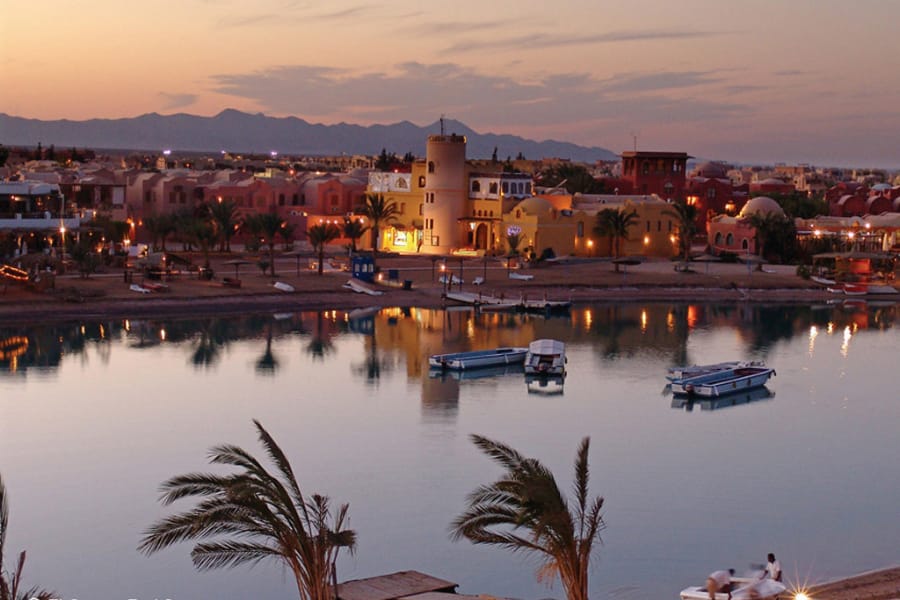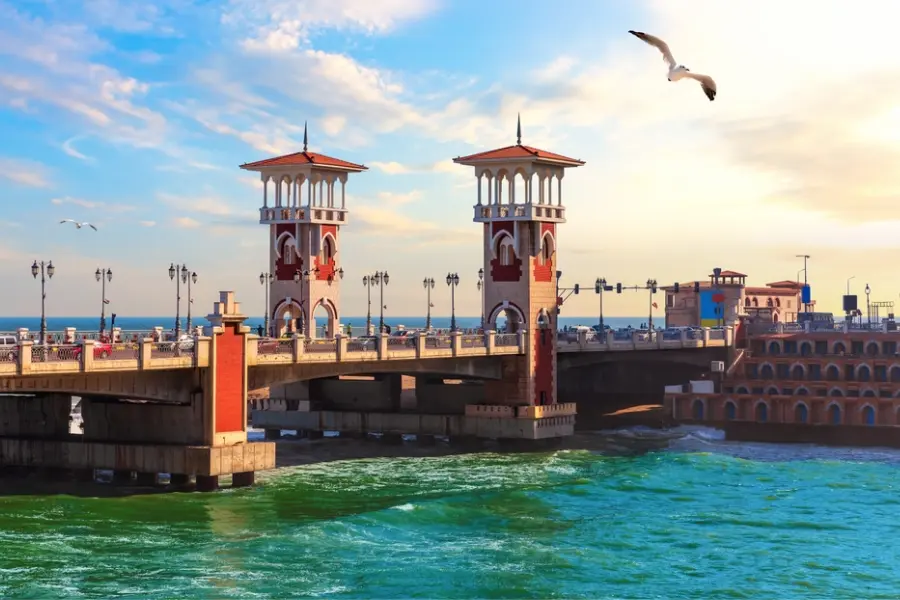Mortuary Temple of Hatshepsut – History, Architecture & Facts
The magnificent Mortuary Temple of Hatshepsut (Djeser-Djeseru) is widely regarded as a masterpiece of ancient Egyptian architecture. It is dramatically carved directly beneath the towering cliffs of Deir el-Bahari, on the west bank of the Nile River near Luxor.
This flawlessly aligned sacred complex was constructed in the 15th century BCE for the legendary female pharaoh, Queen Hatshepsut. Its unique design seamlessly blends massive, multi-level terraces, long ceremonial ramps, and sanctuaries hewn straight into the cliff face.
Dedicated primarily to the state god Amun-Ra, the temple was built to proclaim Queen Hatshepsut’s divine and political legitimacy through stunning, iconic wall reliefs. Among the most famous narrative scenes are the Divine Birth story, which asserts her celestial parentage, and the detailed depictions of the ambitious seafaring Punt Expedition, documenting a successful trade mission. Today, this monumental structure stands as one of Luxor’s greatest highlights, holding its own prestige alongside the nearby Valley of the Kings and the colossal Karnak Temple.
This detailed guide will cover the temple’s location, architectural plan, terraced levels, must-see reliefs, intriguing facts, and practical visitor tips, ensuring you fully appreciate why Queen Hatshepsut‘s monument continues to redefine the concepts of royal power and sacred architectural design.
Key Takeaways
- Name & Era: Djeser-Djeseru, built c. 1470 BCE for Queen Hatshepsut in Luxor, Egypt.
- Function: Royal mortuary temple dedicated to Amun-Ra and the cult of the deified queen.
- Design: Three broad terraces linked by ramps; porticoes cut into the cliff; cliff-hewn sanctuary.
- Iconic reliefs: The Punt Expedition (trade & myrrh trees) and Divine Birth scenes (legitimacy of rule).
- Architect: Often credited to Senenmut, Hatshepsut’s chief architect and steward.
- Where: Deir el-Bahari, west bank of the Nile, near the Valley of the Kings & Karnak.
What is the Mortuary Temple of Hatshepsut?
The Mortuary Temple of Hatshepsut, known to the ancient Egyptians by its sacred name, Djeser-Djeseru (“The Holy of Holies”), was built for a dual, critical purpose: to honor the powerful Queen Hatshepsut after her death as a royal memorial, and to serve as a perpetual site for the worship of the state god Amun-Ra. The temple’s daily rituals and offerings were essential for sustaining her spirit in the afterlife, ensuring her continued prosperity and divine connection.
Far from being a traditional funerary monument, Hatshepsut’s complex fundamentally redefined sacred architecture. Its revolutionary design utilizes dramatic terraced symmetry that blends perfectly with the majestic surrounding cliffs of Deir el-Bahari. This deliberate, innovative layout was not just aesthetic; it was a political statement designed to emphasize her divine connection and forcefully reinforce her political legitimacy as the female pharaoh of Egypt.
Who was Queen Hatshepsut?
Queen Hatshepsut was one of ancient Egypt’s most powerful and visionary rulers (reigned c.1479–1458 BCE). She was the daughter of Thutmose I and the wife of Thutmose II. When her husband died, she initially ruled as regent for the young Thutmose III but later declared herself Pharaoh.
Her reign marked an era of peace, architectural achievement, and trade expansion—including the famous Punt Expedition. Hatshepsut adopted the full royal titulary and even depicted herself in male regalia to emphasize divine kingship.
Where is the Temple of Hatshepsut Located?
The Temple of Hatshepsut lies in Deir el-Bahari, on the west bank of the Nile River opposite Luxor City. It forms part of a vast necropolis that includes the Valley of the Kings and the Valley of the Queens.
The site was chosen for its spiritual symbolism—the western desert represented the realm of the dead where the sun set each day. The cliffs of Deir el-Bahari created a natural backdrop echoing eternity and divine harmony, perfectly framing the temple’s terraced façade.
Architectural Design of the Mortuary Temple
Designed by Senenmut, the temple combines precise symmetry, axial planning, and monumental scale. Its three terraces are connected by ramps, each level dedicated to distinct rituals and divine representations.
Lower Terrace
The entrance terrace featured colonnades and sphinx-lined causeways leading from the valley. It symbolized the transition from earthly to divine space and housed chapels of Anubis and Horus.
Middle Terrace
This level includes the Chapel of Hathor with elegant columns shaped like the goddess’s head and the Portico of Punt—a carved record of Egypt’s trade voyage to the mysterious land of Punt.
Upper Terrace
The uppermost platform held the Sanctuary of Amun-Ra, sacred shrines, and the Divine Birth Colonnade. This level opened directly onto the cliffs—blending human engineering with natural stone in spiritual perfection.
The Punt Expedition Reliefs
The Punt Expedition reliefs on the middle terrace are among Egypt’s most detailed visual records of ancient trade. They show ships sailing the Red Sea to a lush foreign land, bringing back myrrh trees, incense, ebony, and exotic animals.
These carvings illustrate Egypt’s economic power under Hatshepsut and her devotion to Amun-Ra, whose shrine was perfumed with incense imported from Punt.
The Divine Birth Scenes at the Temple of Hatshepsut
Another highlight is the Divine Birth Colonnade, where reliefs narrate the mystical conception of Hatshepsut. The god Amun-Ra visits Queen Ahmose (her mother) in disguise, conceiving the future pharaoh. These scenes legitimized her rule as a daughter of a god, not merely royal blood.
This theme echoed Egypt’s sacred idea that every pharaoh ruled by divine will, but Hatshepsut used it uniquely to justify a woman’s right to sit on the throne.
The Sanctuary and Inner Chambers
At the far end of the upper terrace lies the Sanctuary of Amun, carved directly into the cliff. Inside, priests once offered daily rituals to invoke the god’s spirit. Later periods added chapels to Anubis, Hathor, and Ra-Horakhty.
The sanctuary’s dark interior contrasts sharply with the sunlit terraces outside—symbolizing the journey from life to the divine realm.
Interesting Facts and Modern Discoveries
- Hatshepsut’s name and images were erased by Thutmose III decades after her death, likely for political reasons.
- The temple was later converted into a Coptic Christian monastery during the 7th century CE.
- Polish archaeologists have been restoring the site since the 1960s under the Polish-Egyptian Mission at Deir el-Bahari.
- Modern conservation revealed traces of vivid original pigments on many reliefs.
Visiting the Temple of Queen Hatshepsut Today
The Temple of Hatshepsut is open daily from 6 a.m. to 5 p.m. Visitors usually reach it via a short drive from Luxor’s east bank, crossing the Nile by bridge or ferry. Entry fees are modest, and local guides are available at the gate.
Plan your visit early in the morning for soft light on the cliffs and fewer crowds. Bring water, a hat, and sunblock—especially in summer months. Combine your tour with the Valley of the Kings, Colossi of Memnon, and Karnak Temple for a full-day Luxor experience.
Final Thoughts
The Mortuary Temple of Hatshepsut remains one of ancient Egypt’s most extraordinary monuments—an architectural symphony between stone, desert, and divine belief. Its terraces still echo the ambition of a woman who ruled as Pharaoh, leaving behind a legacy carved into the cliffs of Luxor.
Whether you visit for its grandeur, its reliefs of the Punt Expedition, or simply the serene desert setting, Hatshepsut’s temple continues to inspire admiration for Egypt’s artistry and innovation.
Suggested Luxor & Nile Cruise Tours
If you’re inspired by the Temple of Hatshepsut and want to explore more of Luxor’s ancient wonders, here are some carefully selected Egypt Tours you can book right now — from short day trips to full multi-day adventures across Egypt.
| Tour Name | Type | From |
|---|---|---|
| Luxor West Bank Tour | Day Tour | $65 |
| Luxor East & West Bank Tour | Day Tour | $75 |
| 4 Days Luxor Tour Package | Short Stay | $300 |
| 4 Days Cairo & Luxor Tour | Tour Package | $570 |
| 6 Days Cairo, Luxor, Aswan & Abu Simbel Tour | Tour Package | $830 |
| 10 Days Cairo, Nile Cruise & Alexandria Tour | Tour Package | $1320 |
| 13 Days Cairo, Alexandria, Siwa, Abu Simbel & Luxor | Grand Egypt Tour | $1650 |
| 15 Days Cairo, Sharm El Sheikh, Nile Cruise & Alexandria | Grand Egypt Tour | $1850 |
| 16 Days Cairo, Nile Cruise & Siwa Tour | Ultimate Experience | $1920 |
| 3 Nights Nile Cruise (Aswan → Luxor) | Nile Cruise | $400 |
| 5 Days Nile Cruise (Luxor → Aswan & Abu Simbel) | Nile Cruise | $495 |
| 7 Nights Nile Cruise from Luxor | Nile Cruise | $930 |
✨ Explore more options in our Luxor Tours Collection, Tour Packages, and Nile River Cruises for a tailor-made Egypt experience.
Travel Tip
Pair your visit to the Mortuary Temple of Hatshepsut with a morning tour of the Valley of the Kings or enjoy a Nile River Cruise from Luxor to Aswan to experience Egypt’s most magnificent temples along the riverbanks.
Read more travel inspiration on our blog:
Egypt Travel Blog by ETG Team →
FAQs about the Temple of Hatshepsut
It is located in Deir el-Bahari on Luxor’s West Bank, close to the Valley of the Kings and Colossi of Memnon. The temple lies beneath the cliffs of Deir el-Bahari, forming part of the Theban Necropolis across the Nile from modern Luxor.
The temple was commissioned by Queen Hatshepsut around 1470 BCE and designed by her chief architect Senenmut, who oversaw its construction and alignment with the surrounding cliffs for perfect symmetry.
It honors both Queen Hatshepsut and the god Amun-Ra, showcasing some of the finest examples of New Kingdom architecture. The temple also includes famous reliefs like the Punt Expedition and the Divine Birth scenes, which celebrated Hatshepsut’s divine right to rule.
Key highlights include the Punt Expedition reliefs, the Divine Birth Colonnade, the Chapel of Hathor, and the Sanctuary of Amun. Don’t miss the panoramic view of the terraces and surrounding cliffs.
Exploring the temple usually takes between 45 minutes and 1 hour. Many visitors combine it with nearby attractions like the Valley of the Queens or the Colossi of Memnon on a half-day Luxor West Bank tour.
The best time to visit is from October to April when the weather in Luxor is mild and comfortable. Early morning visits offer the best lighting for photography and fewer crowds.














